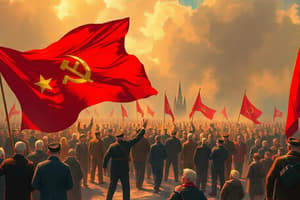Podcast
Questions and Answers
Which of the following factors contributed to the unrest that led to the revolution?
Which of the following factors contributed to the unrest that led to the revolution?
- Stable economic conditions for all social classes.
- Full support from the working class for the Tsar.
- Increased wealth among the aristocracy.
- Lack of political representation and civil liberties. (correct)
What was one significant impact on society following the revolution?
What was one significant impact on society following the revolution?
- Re-establishment of the feudal system.
- A return to monarchical rule.
- The total collapse of the education system.
- Increased participation of women in the workforce and politics. (correct)
Who was the last emperor of Russia whose abdication marked the end of the monarchy?
Who was the last emperor of Russia whose abdication marked the end of the monarchy?
- Tsar Nicholas II (correct)
- Joseph Stalin
- Leon Trotsky
- Vladimir Lenin
What major reform did the Bolsheviks implement regarding land ownership?
What major reform did the Bolsheviks implement regarding land ownership?
Which statement accurately describes the civil war aftermath?
Which statement accurately describes the civil war aftermath?
Which key figure was known for advocating for a proletarian revolution?
Which key figure was known for advocating for a proletarian revolution?
What type of control was established over factories during the Bolshevik reforms?
What type of control was established over factories during the Bolshevik reforms?
What was one of the outcomes of the nationalities policy in the newly formed state?
What was one of the outcomes of the nationalities policy in the newly formed state?
Flashcards are hidden until you start studying
Study Notes
Impact On Society
- Shift from feudal society towards an egalitarian structure, redefining social hierarchies.
- Emergence of the proletariat class, while the influence of bourgeoisie and aristocracy diminished.
- Women's workforce participation surged; women gained the right to vote in 1917, marking a significant societal change.
- Increased government investment in education led to higher literacy rates across the population.
- Nationalities policy was implemented to address the diverse ethnic composition of the Russian Empire.
Causes Of The Revolution
- Political autocracy under Tsar Nicholas II contributed to widespread discontent due to lack of representation and civil liberties.
- Rapid industrialization resulted in poor working conditions and widespread poverty among the peasant class, exacerbated by World War I economic strains.
- Social unrest stemmed from land distribution issues and escalating class tensions between the elite and impoverished communities.
- The influence of intellectuals and revolutionary leaders played a critical role in galvanizing the populace against the regime.
Key Figures
- Vladimir Lenin emerged as the Bolshevik leader, advocating for a revolution to empower the working class.
- Leon Trotsky served as the military leader of the Red Army, promoting the idea of permanent revolution.
- Tsar Nicholas II, the final emperor of Russia, abdicated, leading to the monarchy's dissolution.
- Grigori Rasputin's significant influence within the royal court heightened public anger towards the monarchy.
- Joseph Stalin rose to prominence within the Bolsheviks post-revolution, instrumental in consolidating the party's power.
Bolshevik Reforms
- Land was seized from aristocrats and redistributed to the peasantry, altering land ownership dynamics.
- Factories were placed under workers' control to address workers' rights and grievances effectively.
- Nationalization of key industries occurred, including banks, railroads, and natural resources, shifting economic power to the state.
- The Treaty of Brest-Litovsk enabled Russia to withdraw from World War I, ending involvement in the conflict.
- Introduction of social welfare programs, healthcare reforms, and education initiatives aimed at improving citizens' lives post-revolution.
Civil War Aftermath
- The Civil War (1917-1922) featured a conflict between the Bolshevik Red Army and the anti-Bolshevik White Army, resulting in widespread chaos.
- The death toll was catastrophic, with millions perishing from war-related causes, famine, and disease, leading to significant population displacement.
Studying That Suits You
Use AI to generate personalized quizzes and flashcards to suit your learning preferences.




